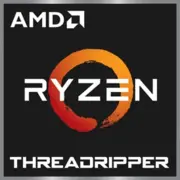AMD Ryzen Threadripper PRO 3975WX

AMD Ryzen Threadripper PRO 3975WX: Comprehensive Review of the Processor for Professionals (2025)
Key Features: The Power of Castle Peak
The AMD Ryzen Threadripper PRO 3975WX, released under the codename Castle Peak, remains the flagship for professional workstations even in 2025. Its Zen 2 architecture, built on TSMC's 7nm FinFET process, offers a balance between performance and energy efficiency. Here are the key specifications:
- 32 cores / 64 threads — the maximum for the Threadripper PRO 3000 series.
- 128 MB L3 cache — critical for data-intensive tasks (rendering, modeling).
- TDP 280W — requires serious cooling.
- Geekbench 6: 1656 (Single-Core) / 14729 (Multi-Core).
Key Features:
- Support for 128 PCIe 4.0 lanes — for multi-drive NVMe arrays and multiple GPUs.
- AMD PRO technologies: hardware data protection, remote management.
- Compatibility with 8-channel DDR4 memory — up to 2TB of RAM.
Compatible Motherboards: Choosing a Platform
The processor uses the sWRX8 socket, and compatible motherboards are built on the WRX80 chipset. These are premium solutions aimed at the enterprise sector. Examples of models (2025):
- ASUS Pro WS WRX80E-SAGE SE ($700–800): 7 PCIe 4.0 x16 slots, 8 SATA ports, 10 Gbit Ethernet.
- GIGABYTE WRX80 SU8 ($650–750): ECC memory support, 8 M.2 slots via adapters.
Selection Features:
- Make sure to have a robust VRM unit (at least 16 phases) for stability under load.
- Check for 8-channel memory support — boards feature 8 DIMM slots.
- Workstation models with Thunderbolt 4 and 10G LAN are preferred.
Supported Memory: DDR4 — A Tried and Tested Foundation
The Threadripper PRO 3975WX works only with DDR4 (DDR5 is not supported). Recommended specifications:
- Frequency: 3200–3600 MHz (optimal balance with Infinity Fabric).
- Configuration: 8 modules to enable 8-channel mode (e.g., 8×32 GB = 256 GB).
- Type: ECC memory — essential for high-reliability tasks (CAD, server workloads).
Why not DDR5? The Zen 2 architecture was originally designed for DDR4, and the shift to DDR5 in the PRO line only occurred in the 5000 series.
Power Supplies: Headroom — The Key to Stability
With a TDP of 280W and energy demands on the VRM, the minimum recommended power rating for the PSU is 1000W (considering a discrete GPU like the NVIDIA RTX 4090 or Radeon PRO W7800).
Recommendations:
- 80+ Platinum/Titanium certification (efficiency >90%).
- Modular cables — for ease of assembly and ventilation.
- Example models:
- Corsair AX1600i ($450) — digital control, quiet operation.
- Seasonic PRIME TX-1300 ($400) — reliable Japanese component base.
Important! Cheap PSUs may not withstand peak loads during rendering, leading to reboots.
Pros and Cons: For Whom is 3975WX an Excess, and for Whom is it a Necessity
Pros:
- Best-in-class multi-threaded performance — rendering in Blender on 32 cores is completed twice as fast compared to the 16-core Ryzen 9 5950X.
- Support for 8-channel memory — speeds up to 204 GB/s compared to 50–60 GB/s on AM5 platforms.
- Extended warranty — 5 years for PRO models.
Cons:
- Price — the processor costs around $2500 (Intel Xeon W-3375 equivalents are $3000).
- Power consumption — the system consumes from 150W even at idle.
- Limited upgradeability — only 3000/5000 PRO series processors are available for the sWRX8 socket.
Use Cases: Not for Gaming!
Gaming:
- Performance in Full HD/1440p is 20–30% lower than the Ryzen 7 7800X3D due to lower core frequencies (3.5–4.2 GHz).
Work Tasks:
- 3D rendering (KeyShot, V-Ray): 32 cores reduce the rendering time of complex scenes from hours to minutes.
- Virtualization — running 10+ VMs simultaneously without lag.
- Scientific computing (MATLAB, ANSYS) — speeding up calculations by 4–5 times compared to 16-core CPUs.
Multimedia:
- Video encoding in DaVinci Resolve: rendering an 8K project takes 15–20 minutes.
Comparison with Competitors: Threadripper vs. Xeon
1. Intel Xeon W-3375 (2023):
- 38 cores / 76 threads, DDR4-3200, 57 MB cache.
- Pros: Support for AVX-512, DDR5 (in new models).
- Cons: Price ($4000), TDP 270W, fewer PCIe lanes (64 vs. 128).
2. AMD Ryzen Threadripper PRO 5995WX (2025):
- 64 cores / 128 threads, DDR5-5200, 256 MB cache.
- Pros: +100% multi-threaded performance.
- Cons: Price from $6000, requires a new platform.
Conclusion: The 3975WX wins over Intel in price and energy efficiency but falls short against the new 5000 Threadrippers in speed.
Practical Assembly Tips
1. Cooling:
- Liquid Cooling with a 360mm radiator (e.g., Arctic Liquid Freezer III). Air coolers like Noctua NH-U14S TR4 will manage, but will be loud under load.
2. Case:
- Minimum Mid-Tower with ventilation (Fractal Design Define 7 XL, Lian Li PC-O11 Dynamic XL).
3. Storage:
- Use PCIe 4.0 NVMe (WD Black SN850X, Samsung 990 PRO) for projects.
4. Assembly:
- Ensure that the cooler mounting is compatible with sWRX8.
- When installing 8 memory modules, enable the XMP profile in UEFI.
Final Conclusion: Who is the 3975WX Suitable For?
This processor is a tool for professionals who require maximum multi-threading:
- Visual effects studios — real-time rendering.
- Engineers — CFD calculations, structural modeling.
- Data Science — training neural networks on local machines.
Why not choose the Ryzen 9 7950X? For 32-core loads, the 3975WX is more stable due to its 8-channel memory and larger cache.
Target Audience: Those for whom time = money. If your project generates $500 per hour, saving 3 hours on rendering will cover the price difference with a regular CPU.
Relevance in 2025: Despite the release of new models, the 3975WX remains a cost-effective choice in the secondary market (price around $1800) for upgrading older workstations.
Basic
CPU Specifications
Memory Specifications
GPU Specifications
Miscellaneous
Benchmarks
Compared to Other CPU
Share in social media
Or Link To Us
<a href="https://cputronic.com/en/cpu/amd-ryzen-threadripper-pro-3975wx" target="_blank">AMD Ryzen Threadripper PRO 3975WX</a>